Phantom Thread: An Insight into Autism and Relationships | Clothes on Film – Part 36622
SPOILERS
If you’ve heard anything about Phantom Thread (2017, directed by Paul Thomas Anderson), you are bound to uncover a multitude of thoughts on the astounding Academy Award winning costume work of Mark Bridges or the retirement role of Daniel Day-Lewis as Reynolds Woodcock, 1950s fashion house couturier. But one of the key components to Reynolds is missing from the discussion: Autism.
 Reynolds’ (Daniel Day-Lewis) daily dressing routine.
Reynolds’ (Daniel Day-Lewis) daily dressing routine.Phantom Thread opens with Reynolds (Day-Lewis) getting dressed to formalities of the era. Polished shoes, ironed trousers, a fresh button-down shirt, with the addition of long magenta socks to introduce the notion of creativity, or perhaps particularities to the character. The scene moves to breakfast, which quietly adds that Reynolds likes things done a certain way even if the rest of the house is not on board. This time it’s his tea. While others take their tea from a typical silver pot, Reynolds has his own Asian influenced teapot and cuplike saucer from which to drink. Of course these things say little more than showcase a human with individuality, but they start to paint the picture.
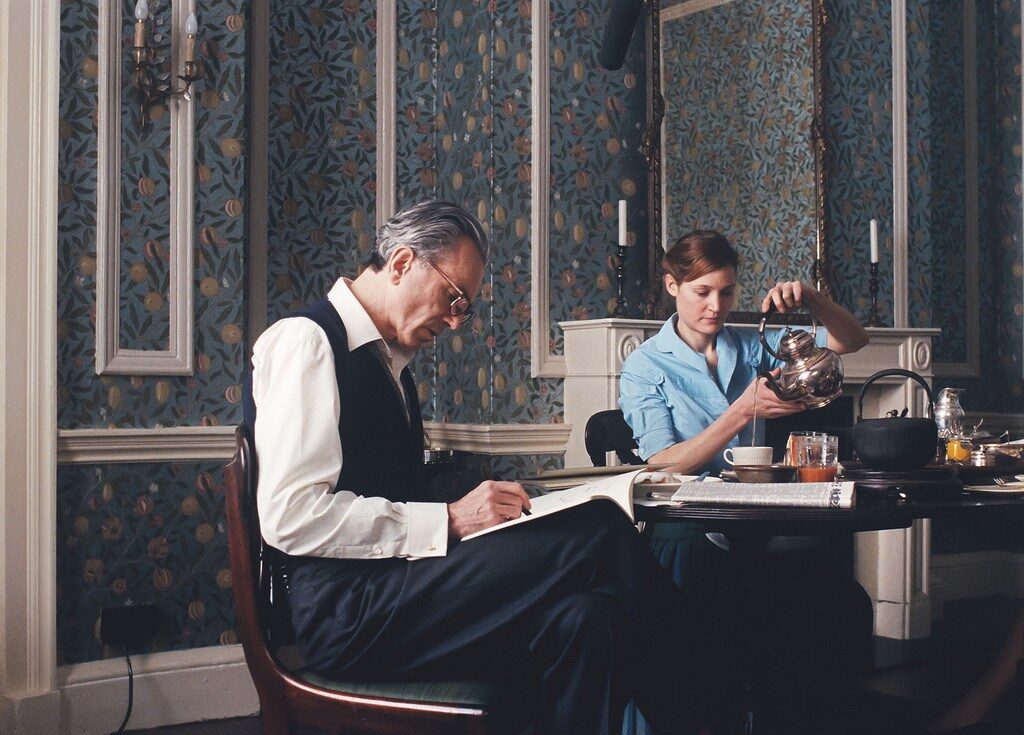
A later breakfast scene with Alma (Vicky Krieps) showcasing the idiosyncrasy of how Reynolds takes his tea.
It becomes apparent at breakfast that a relationship is in its final stages of disintegration, hanging on simply because doing otherwise requires a conflict that Reynolds is not ready to face. Morning proves too difficult as Johanna (Camilla Rutherford), current partner to the designer, disrupts the flow and routine in place with a final attempt to regain his attention – interrupting a sketching Reynolds with the offering of pastries invites a curt response expressing his disdain for such “gloopy” things and that frankly she should know this. Stunned and hurt she entreats, “Where have you gone Reynolds?” “There’s nothing I can say to get your attention back at me.” Unable to deal with such emotion on a dress-delivering day, he waves her words away stating, “I cannot start my day with a confrontation. I simply have no time for confrontations”. That is the last we see of her as Cyril (Lesley Manville), Reynolds sister, manager, protector, and constant companion offers to send her packing for him.
 Reynolds with his sister Cyril (Lesley Manville) sharing a rare smile.
Reynolds with his sister Cyril (Lesley Manville) sharing a rare smile.It is not uncommon for those with autism to need everything ‘just so’ at the start of a very stressful day. So often laser focused on how the day should proceed, big displays of emotion can knock them off kilter so much that there is little else they can think about, making it all the more harder “to recover through the rest of the day”. Reynolds isn’t trying to be distant or gruff, he’s just immersed in his work and trying to keep the proper headspace to just make it through the next twenty four hours.
 Countess Henrietta Harding (Gina McKee) in her final fitting.
Countess Henrietta Harding (Gina McKee) in her final fitting.The film continues with the fitting and debut of a gown designed for Countess Henrietta Harding (Gina McKee). Our first glimpse at the work from the House of Woodcock is a heavy look constructed from burgundy velvet with a light pink, possibly taffeta, peek-a-boo skirt. Surprisingly, the gown seems to not be forward thinking at all but rather situated in the past; Renaissance influenced with a ruff-like collar, emphasising hip pads, and 16th century slashing details. Beautiful and seemingly fit for royalty, but perhaps ever so slightly dowdy.
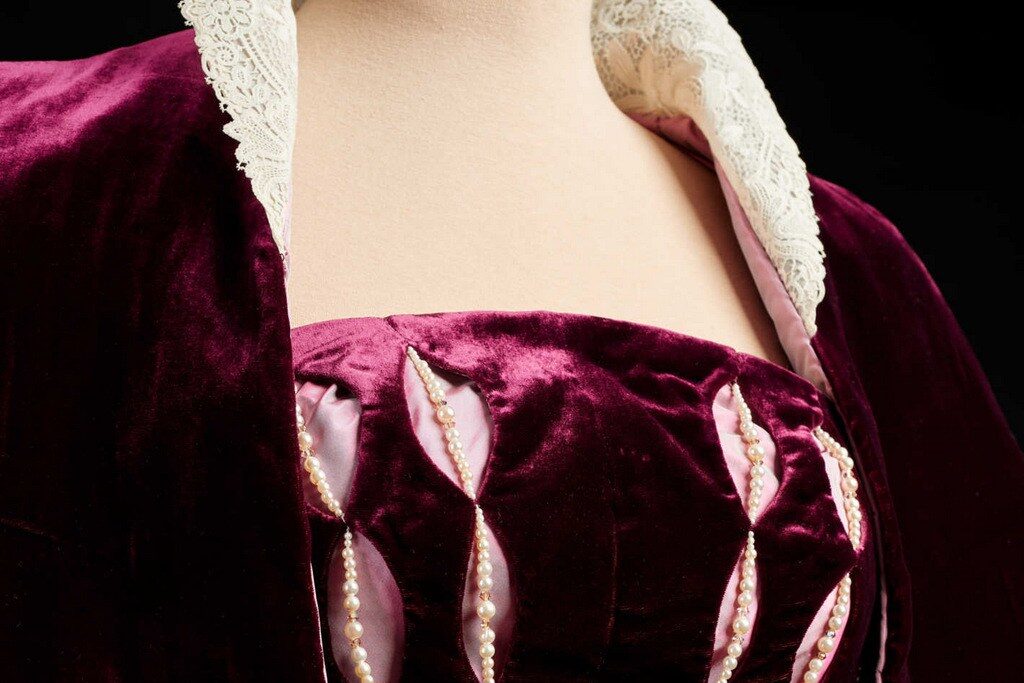 Renaissance detailing for Countess Henrietta Harding’s gown.
Renaissance detailing for Countess Henrietta Harding’s gown.Reynolds is nothing but charming with the Countess. In fact, he seems to mask all traces of irritation and the need for control around his clients. Endearing each of them and the audience with his boyish smiles and twinkly eyes.
 A charming Reynolds that often invokes the jealousy of young Alma.
A charming Reynolds that often invokes the jealousy of young Alma.This comes with a price though, for when his work is completed, the need to hide away in the countryside to recover from the imminent exertion and low that follows is a necessary consequence of being an autistic man in a neurotypical world. By pushing himself to meet the demands of such a ruthless profession, as well as trying to hide the more difficult aspects of his persona, he becomes utterly depleted. But the solitude and simplicity of the countryside allows him to let down his walls a bit and become more open. It is in this state that he is more available to touch, affection, and care. Unsurprisingly, this is when he finds Alma (Vicky Krieps).
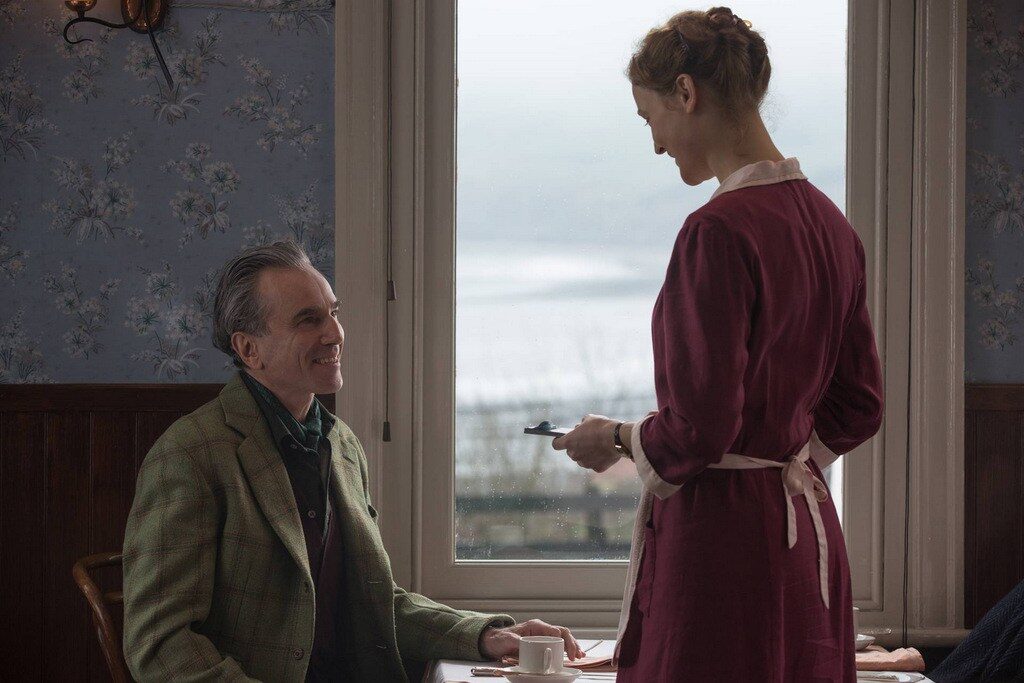 Reynolds’ first meeting with Alma.
Reynolds’ first meeting with Alma.From a world of manners and uptight social rules, it is the opposite in Alma that he finds charming. Sitting down to breakfast at a little country establishment, he locks eyes and giggles with her as she stumbles out of the kitchen to start her waitressing duties (the reader might find it interesting to note that this stumble was quite an accident on the part of actress). In this moment they are both without stuffy pretense and connect on a basic human level. People with autism often “struggle to make sense of social signals in real time” but because this meeting was so raw and uninhibited, Reynolds could make sense of her person right away. He’s so fascinated by her ‘realness’ that he asks her to dinner right away.
 Alma’s first date dress.
Alma’s first date dress.Stunning in a 1940s basque waist, cherry red dress, Alma continues to enchant Reynolds later that evening. But the complexities of their relationship are apparent right away. Reynolds is very much her senior and so sure of his opinions. Making pronouncements such as, “I think it’s the expectations and assumptions of others that cause heartache”, or telling her to keep a photo of her mother on her person always, and physically wiping Alma’s lipstick off because, “I like to see who I’m talking to”. While many viewers start raising their pitchforks at this semblance of domineering masculinity, one needs to dig deeper. Yes, Reynolds is testing his level of control in their relationship, but if he is able to feel slightly in control this actually allows him to be more relaxed and himself.
Moreover, while she is trusting and young, Alma is much too strong a woman to be pushed around, quipping, “If you want to have a staring contest with me, you will lose”. It’s flirty and spoken shyly but you can hear her inner fire. The fact is that she can leave at any time, and she knows this, Reynolds knows this, but she chooses to stay, to see this out, to make sense of the connection she has with this paradoxical man.
 Reynolds showing more affection in a more relaxed environment.
Reynolds showing more affection in a more relaxed environment.Having regained his strength to face the neurotypical world again, Reynolds invites Alma to share his routine based life. As she is thrust into this busy but structured world of beautiful women, dinners, and focused work, the occasional loneliness of loving someone with autism becomes clear. There are moments of connection and off-screen passion but for Alma who thrives on quality time and serving her partner, she often feels neglected when Reynolds is consumed by his work for days and more likely weeks on end. Separate bedrooms, hushed breakfasts, constant bombardment of people, silenced opinions – Alma starts to wonder what she is doing there. Taking matters into her own hands, she decides to surprise Reynolds with a birthday supper, just the two of them. Although advised quite strongly by Cyril not to go forward with this plan, Alma stands her ground. Little does she know that surprises and unknown alterations to the life of someone with autism, no matter how well intentioned, cause such anxiety almost to the point of, and in some cases, a breakdown.
 Reynolds angry at the “ambush” to his routine.
Reynolds angry at the “ambush” to his routine.Coming in from his nightly walk, Reynolds notices right away that something is different. When presented with the knowledge that everyone has been dismissed for the evening and a homemade meal prepared for the two of them, Reynolds manages to hold in most of his displeasure and takes his leave for a hot bath, perhaps in an effort to deal with the change for the evening. Normally very formal and put together, Reynolds then trudges down the stairs wearing lavender pajamas under a tweed suit coat with a silk cravat for flair, using his attire to express his irritation at the disruption to his evening (Day-Lewis put this look together on his own). But whatever reconciliation or declaration of love Alma was expecting, she was certainly not going to find it like this. Those with autism love in their own way and on their own time and when demanded upon generally shut down or become contentious. And so the dinner is ruined with a massive quarrel, but not before finally pinpointing the root of Alma’s anxiety; it is twofold, a distance between them and feeling inessential to him.
 Interrupting a focused Reynolds.
Interrupting a focused Reynolds.Coming full circle to Reynolds foretelling thoughts on expectation and assumptions. Alma is expecting a neurotypical relationship from a man that clearly has autism. And the only way, besides plainly communicating their needs, which seems unlikely to happen, is to pay attention and respond in kind. There are missteps of course, falling back into how she wants to love Reynolds versus how he needs to be loved, illustrated prominently when she brings Reynolds a pot of tea as he’s working. He refuses the tea and continues exasperated, “the tea is leaving, but the interruption is staying right here with me”. Yet Alma starts to learn what is necessary to becoming an integral part of the household – reducing her noise at breakfast, taking up a needle and thread on a late night, etc.
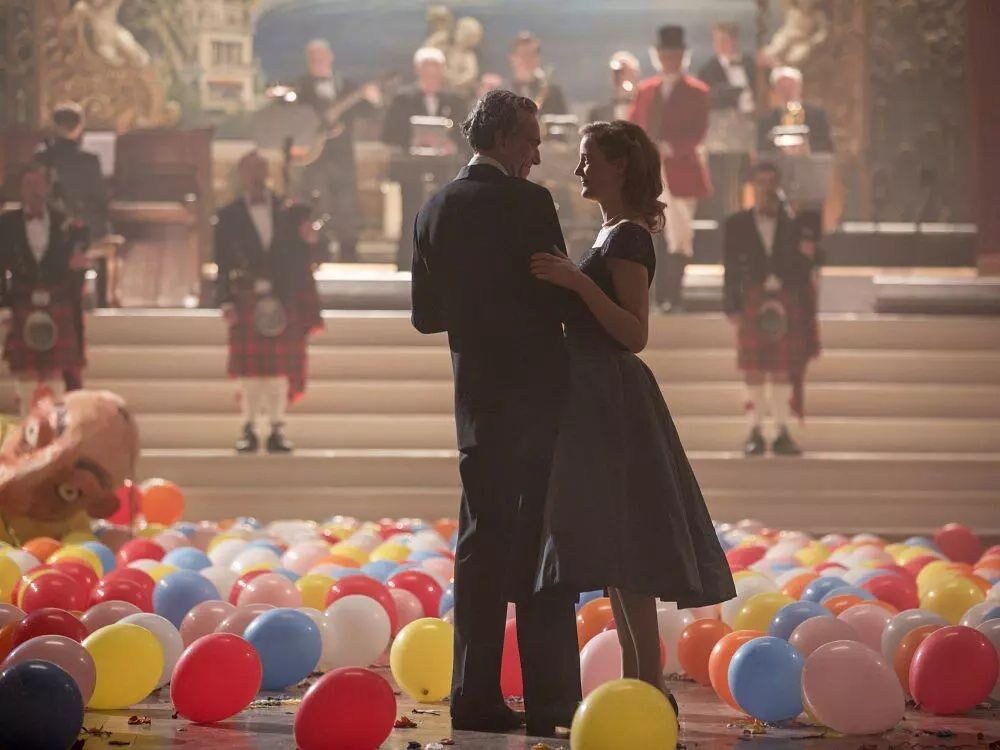 A moment of compromise between Reynolds and Alma.
A moment of compromise between Reynolds and Alma.Though nothing said more for her dedication to Reynolds than while dealing with a necessary but more difficult and slightly embarrassing patron, Barbara Rose (played by Harriet Sansom Harris, whose character is based on Heiress Barbara Hutton). Watching Barbara collapse from intoxication at her own wedding dinner, Alma gets more and more disgusted at the disrespect shown to Reynolds work. Eventually marching up to her bedroom and removing the gown from her comatose body and making it known to all in the room, “it is no business of ours how Mrs. Rose behaves, but she can no longer act like this and be dressed by the House of Woodcock”. Reynolds is quite overwhelmed at this passionate display that not just conveyed her love but more importantly her respect; respect for his work, for his mind, for who he is at his core. He starts to realise there is nothing more moving than to have someone in his corner, who will fight for him, fight for their relationship, no matter how challenging he is at times.
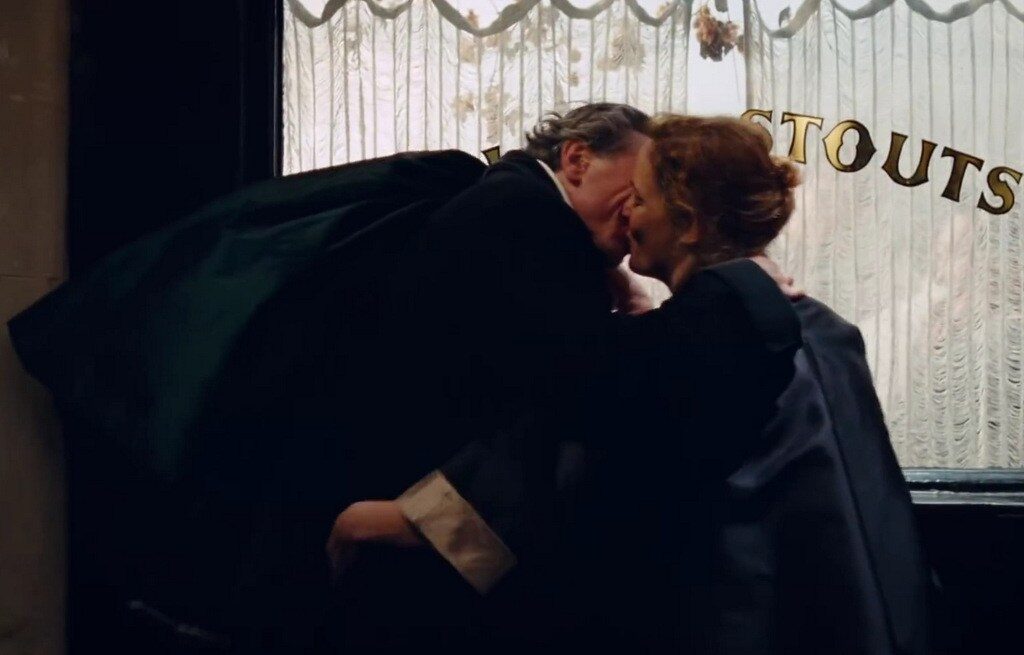 Reynolds overcome by Alma’s expression of respect.
Reynolds overcome by Alma’s expression of respect.Of course, Reynolds is not the only one who is difficult. Alma has so much love to give but she is young and impatient and stubborn. The truth is, love is hard. Living with another person and loving someone unconditionally is one of the most selfless acts a human can give. And loving someone with autism can be even harder. But hard does not mean bad or that it should be avoided. In fact when the connection is so palpable and the passion and love for each other that strong, being able to compromise and make a challenging but electric relationship thrive is all the more rewarding.
By Allison Dredge.
Allison Dredge is a costume designer, anglophile, and traveller.
© 2018, Lord Christopher Laverty.